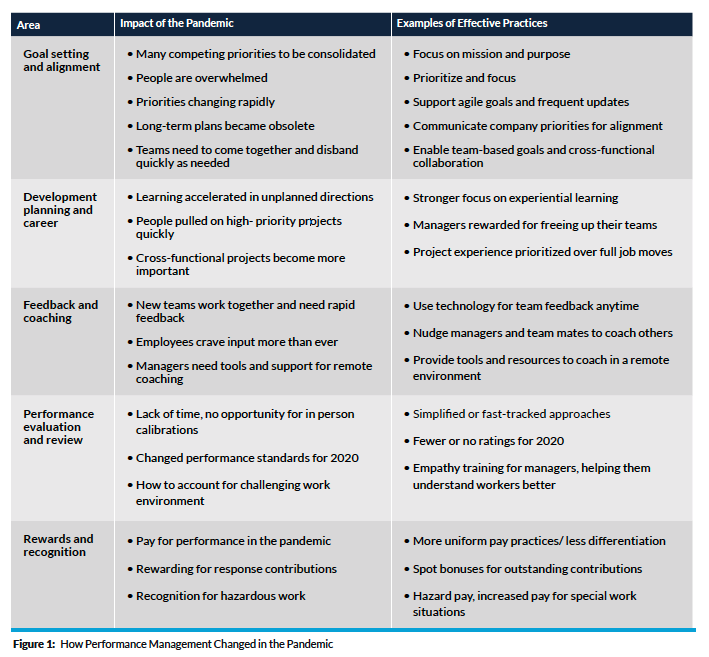
* By Josh Bersin, 2021
Performance management has been a topic of debate and discussion for decades. We’ve transformed management systems, thrown out ratings, focused on dialogue, implemented feedback and recognition platforms, created complex OKR systems, and reworked pay for performance calculations. Yet, a 2018 Deloitte study of over 1,000 organizations across the globe showed that performance management is still the most despised people process, with a net promoter score of minus 60.
Pandemic Performance Management
In March 2020, as most countries experienced huge economic disruptions from the global COVID-19 pandemic, performance management was yet again on the mind of many HR and leadership teams.
Leaders grappled with how to fairly evaluate employee performance in the middle of a pandemic. Should we continue with our existing process? Scrap it altogether? Simplify it for this year only? Or quickly redesign it for the future?
We’ve seen all four of these approaches implemented. Most companies continued with their existing processes. Some companies – especially those with lots of money like Facebook and Google – gave everybody the same outstanding rating. Intuit, the global technology platform and maker of TurboTax, QuickBooks and Mint, went from four ratings to two for its May 2020 reviews. Deutsche Telekom and AB InBev fast tracked their performance management transformations to build for the future.
At the same time, companies had to deal with the question of how to distribute rewards. Those companies hardest hit in the pandemic downturn – such as hospitality, transportation, and consumer products – had to think about how to split up an ever-decreasing pie. Should everybody get the same share? What about the star performers? Should those who didn’t meet their goals get penalized because conditions out of their control — such as children at home, parents to care for, or their own health issues – impacted their work?
Again, we saw approaches vary. Those that didn’t change their performance management approach often used the same pay process as well, but just cut budgets (or enlarged them, in the case of business upticks). Big tech giants linked significant bonus and rewards increases to outstanding performance evaluations; those companies that fast-tracked performance management simplification also carried related changes to pay practices.
Goals More Important Than Ever
Beyond the immediate necessity of dealing with year-end evaluation and rewards cycles, one area of performance management was cast into the spotlight: the importance of clear, agile, team-oriented goals to drive the right actions and align every individual to the mission and purpose of the organization. The old way of cascading rigid goals, locking them down in the first quarter, and not looking at them until year end no longer worked.
Goal management systems were clunky, complicated, and became an end in themselves. HR people often measured the success of their performance management program by process measures like the number of employees completing goal setting on time.
The most effective goals are those that reflect the work to be done, align teams around the work, and create transparency and line of sight. The OKR (objectives and key results) method is a good framework to accomplish this. Effective goal setting is based on common factors that are more now more important than ever.
- Start with the mission and purpose
- Define company objectives with input from key stakeholders and employees
- Focus goals on outcomes
- Goal transparency is key
- Autonomy in goal setting drives engagement
- Team-based goals for collaboration
- Calibrate goals, not just performance ratings, for equity
- Balance operational and aspirational goals
- Update goals and progress frequently
- Use technology in the flow of work
Conclusion
One of the many lessons we’ve learned from the pandemic is what good performance management looks like. Important factors include: setting clear goals aligned with a clear purpose and mission; supporting teams to work together; empowering autonomy of employees to do the right things; frequent and effective feedback and coaching; simple and work embedded evaluation approaches that are fair and empathetic; and equitable pay practices. Technology that makes work easier – not harder – and supports clarity, alignment and collaboration is key. Many organizations are now rethinking their performance management approaches in light of the ongoing business change we will see for the foreseeable future. Let’s hope this reevaluation, coupled with the technology innovation now available, can be a turnaround for performance management – moving it from its ranking as the most despised people process to one that is viewed as essential for business and employee success.
Want to get a glimpse of the industry’s top performance management systems? Click the button below to find out now!

Scan QR code to follow WeChat public account
Never miss any talent management information




